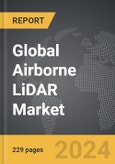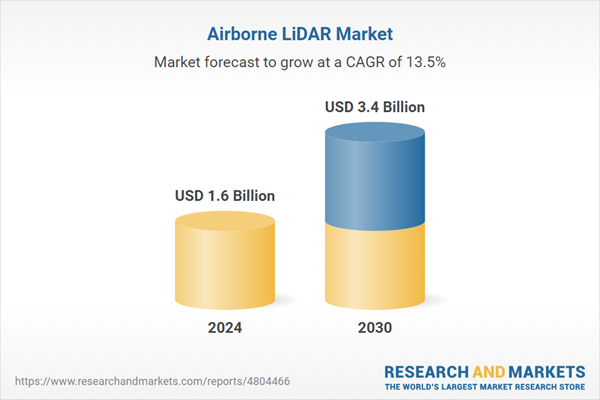The global market for Airborne LiDAR was valued at US$1.6 Billion in 2024 and is projected to reach US$3.4 Billion by 2030, growing at a CAGR of 13.5% from 2024 to 2030. This comprehensive report provides an in-depth analysis of market trends, drivers, and forecasts, helping you make informed business decisions. The report includes the most recent global tariff developments and how they impact the Airborne LiDAR market.
Segments: Type (Topographic, Bathymetric); Platform (Fixed Wing Aircraft, Rotary Wing Aircraft, UAVs); Application (Corridor Mapping, Seismology, Exploration & Detection, Other Applications).
Geographic Regions/Countries: World; USA; Canada; Japan; China; Europe; France; Germany; Italy; UK; Spain; Russia; Rest of Europe; Asia-Pacific; Australia; India; South Korea; Rest of Asia-Pacific; Latin America; Argentina; Brazil; Mexico; Rest of Latin America; Middle East; Iran; Israel; Saudi Arabia; UAE; Rest of Middle East; Africa.
The analysts continuously track trade developments worldwide, drawing insights from leading global economists and over 200 industry and policy institutions, including think tanks, trade organizations, and national economic advisory bodies. This intelligence is integrated into forecasting models to provide timely, data-driven analysis of emerging risks and opportunities.
Global Airborne LiDAR Market - Key Trends and Drivers Summarized
How Does Airborne LiDAR Transform Mapping and Surveying?
Airborne LiDAR (Light Detection and Ranging) has revolutionized the fields of mapping and surveying by providing highly accurate and detailed three-dimensional representations of the Earth's surface. This technology uses laser pulses emitted from aircraft to measure distances to the ground, capturing precise data on topography, vegetation, and built structures. Unlike traditional surveying methods, airborne LiDAR can penetrate vegetation cover and collect data over vast areas in a relatively short time. This capability makes it invaluable for applications such as topographic mapping, forest inventory, and urban planning. The precision of LiDAR data allows for detailed analysis and modeling, which is crucial for infrastructure development, flood risk assessment, and natural resource management. The technology's ability to produce high-resolution digital elevation models (DEMs) and terrain maps has set new standards in accuracy and efficiency, making it a preferred tool for both governmental and private sector projects worldwide.What Technological Advances Have Enhanced Airborne LiDAR Systems?
Recent technological advancements have significantly enhanced the performance and applicability of airborne LiDAR systems. Innovations in laser technology have led to the development of more compact, energy-efficient, and powerful LiDAR sensors. These sensors can capture higher resolution data at greater ranges, improving the quality and accuracy of the collected information. The integration of Global Navigation Satellite Systems (GNSS) and Inertial Measurement Units (IMUs) has also improved the precision of LiDAR systems by providing accurate positioning and orientation data. Furthermore, advancements in data processing software have enabled faster and more efficient handling of large datasets, facilitating real-time data analysis and visualization. The miniaturization of LiDAR systems has opened up new applications in smaller unmanned aerial vehicles (UAVs), making LiDAR accessible for a wider range of uses, including in areas that are difficult to access with traditional aircraft. These technological enhancements not only expand the capabilities of airborne LiDAR but also reduce the costs associated with data acquisition and processing, making it more accessible to various industries.What Are the Key Applications and Market Challenges for Airborne LiDAR?
Airborne LiDAR has a wide range of applications across multiple industries, but it also faces several challenges. In urban planning and smart city development, LiDAR provides critical data for creating detailed 3D city models, helping planners design more efficient and resilient urban infrastructures. In environmental monitoring, LiDAR is used to map and analyze forests, wetlands, and coastal areas, providing data essential for conservation and resource management. The technology is also pivotal in disaster management, where it helps assess risks and guide emergency response planning. However, the high costs associated with LiDAR technology, including equipment, data processing, and skilled labor, can be a barrier to entry for smaller organizations. Additionally, the need for specialized training to operate and interpret LiDAR data poses another challenge. The large volumes of data generated by LiDAR surveys require significant storage and processing capabilities, which can be a logistical and financial burden. Despite these challenges, the benefits of accurate and high-resolution data continue to drive the adoption of LiDAR across various sectors.What Drives the Growth in the Airborne LiDAR Market?
The growth in the airborne LiDAR market is driven by several factors, including technological advancements, expanding applications, and increasing demand for high-precision data. Technological innovations, such as more powerful sensors and improved data processing capabilities, have enhanced the efficiency and affordability of LiDAR systems. These advancements have opened new market opportunities, particularly in sectors like autonomous vehicles and UAVs, where precise environmental mapping is crucial. The expanding use of LiDAR in urban planning, infrastructure development, and environmental monitoring reflects a growing need for accurate and comprehensive data to support decision-making processes. Moreover, regulatory support for disaster management, environmental conservation, and smart city initiatives is propelling the demand for airborne LiDAR. As governments and private organizations seek to optimize resource management and mitigate risks, the adoption of LiDAR technology continues to rise. The increasing interest in real-time data analytics and the integration of LiDAR with other geospatial technologies, such as GIS, are also significant growth drivers. These factors collectively contribute to a robust and expanding market for airborne LiDAR, offering new opportunities for innovation and application in the coming years.Report Scope
The report analyzes the Airborne LiDAR market, presented in terms of units. The analysis covers the key segments and geographic regions outlined below.Segments: Type (Topographic, Bathymetric); Platform (Fixed Wing Aircraft, Rotary Wing Aircraft, UAVs); Application (Corridor Mapping, Seismology, Exploration & Detection, Other Applications).
Geographic Regions/Countries: World; USA; Canada; Japan; China; Europe; France; Germany; Italy; UK; Spain; Russia; Rest of Europe; Asia-Pacific; Australia; India; South Korea; Rest of Asia-Pacific; Latin America; Argentina; Brazil; Mexico; Rest of Latin America; Middle East; Iran; Israel; Saudi Arabia; UAE; Rest of Middle East; Africa.
Key Insights:
- Market Growth: Understand the significant growth trajectory of the Topographic LiDAR segment, which is expected to reach US$1.9 Billion by 2030 with a CAGR of a 13.2%. The Bathymetric LiDAR segment is also set to grow at 13.9% CAGR over the analysis period.
- Regional Analysis: Gain insights into the U.S. market, valued at $426.1 Million in 2024, and China, forecasted to grow at an impressive 18.3% CAGR to reach $799.3 Million by 2030. Discover growth trends in other key regions, including Japan, Canada, Germany, and the Asia-Pacific.
Why You Should Buy This Report:
- Detailed Market Analysis: Access a thorough analysis of the Global Airborne LiDAR Market, covering all major geographic regions and market segments.
- Competitive Insights: Get an overview of the competitive landscape, including the market presence of major players across different geographies.
- Future Trends and Drivers: Understand the key trends and drivers shaping the future of the Global Airborne LiDAR Market.
- Actionable Insights: Benefit from actionable insights that can help you identify new revenue opportunities and make strategic business decisions.
Key Questions Answered:
- How is the Global Airborne LiDAR Market expected to evolve by 2030?
- What are the main drivers and restraints affecting the market?
- Which market segments will grow the most over the forecast period?
- How will market shares for different regions and segments change by 2030?
- Who are the leading players in the market, and what are their prospects?
Report Features:
- Comprehensive Market Data: Independent analysis of annual sales and market forecasts in US$ Million from 2024 to 2030.
- In-Depth Regional Analysis: Detailed insights into key markets, including the U.S., China, Japan, Canada, Europe, Asia-Pacific, Latin America, Middle East, and Africa.
- Company Profiles: Coverage of players such as Airborne Imagining Inc., Dibotics, FLIR Systems, Inc., Leica Geosystems AG, Merrick & Company, Inc. and more.
- Complimentary Updates: Receive free report updates for one year to keep you informed of the latest market developments.
Some of the 12 companies featured in this Airborne LiDAR market report include:
- Airborne Imagining Inc.
- Dibotics
- FLIR Systems, Inc.
- Leica Geosystems AG
- Merrick & Company, Inc.
- SAAB AB
- Teledyne Technologies Inc.
- Velodyne Lidar, Inc.
- Xactsense
Tariff Impact Analysis: Key Insights for 2025
Global tariff negotiations across 180+ countries are reshaping supply chains, costs, and competitiveness. This report reflects the latest developments as of April 2025 and incorporates forward-looking insights into the market outlook.The analysts continuously track trade developments worldwide, drawing insights from leading global economists and over 200 industry and policy institutions, including think tanks, trade organizations, and national economic advisory bodies. This intelligence is integrated into forecasting models to provide timely, data-driven analysis of emerging risks and opportunities.
What’s Included in This Edition:
- Tariff-adjusted market forecasts by region and segment
- Analysis of cost and supply chain implications by sourcing and trade exposure
- Strategic insights into geographic shifts
Buyers receive a free July 2025 update with:
- Finalized tariff impacts and new trade agreement effects
- Updated projections reflecting global sourcing and cost shifts
- Expanded country-specific coverage across the industry
Table of Contents
I. METHODOLOGYII. EXECUTIVE SUMMARY2. FOCUS ON SELECT PLAYERSIII. MARKET ANALYSISCANADAITALYSPAINRUSSIAREST OF EUROPESOUTH KOREAREST OF ASIA-PACIFICARGENTINABRAZILMEXICOREST OF LATIN AMERICAIRANISRAELSAUDI ARABIAUNITED ARAB EMIRATESREST OF MIDDLE EASTIV. COMPETITION
1. MARKET OVERVIEW
3. MARKET TRENDS & DRIVERS
4. GLOBAL MARKET PERSPECTIVE
UNITED STATES
JAPAN
CHINA
EUROPE
FRANCE
GERMANY
UNITED KINGDOM
ASIA-PACIFIC
AUSTRALIA
INDIA
LATIN AMERICA
MIDDLE EAST
AFRICA
Companies Mentioned (Partial List)
A selection of companies mentioned in this report includes, but is not limited to:
- Airborne Imagining Inc.
- Dibotics
- FLIR Systems, Inc.
- Leica Geosystems AG
- Merrick & Company, Inc.
- SAAB AB
- Teledyne Technologies Inc.
- Velodyne Lidar, Inc.
- Xactsense
Table Information
| Report Attribute | Details |
|---|---|
| No. of Pages | 345 |
| Published | April 2025 |
| Forecast Period | 2024 - 2030 |
| Estimated Market Value ( USD | $ 1.6 Billion |
| Forecasted Market Value ( USD | $ 3.4 Billion |
| Compound Annual Growth Rate | 13.5% |
| Regions Covered | Global |









